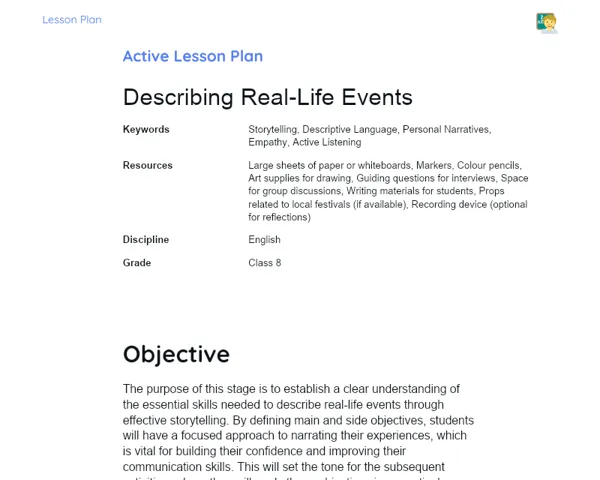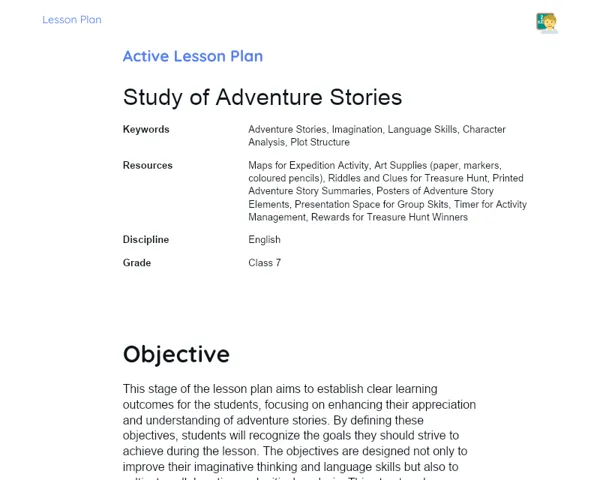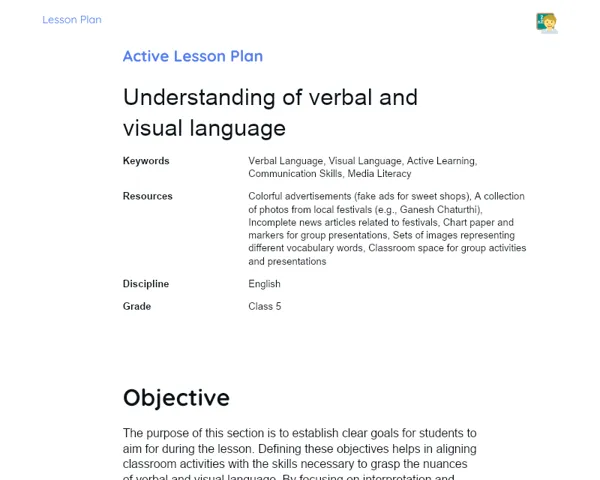Lesson Plan | Socioemotional Learning | Use of Appropriate Stress in Poetry
| Keywords | Stress in Poetry, Emotional Expression, RULER Method, Self-Awareness, Self-Management, Social Skills, Cognitive Development, Poetic Meter, Interactive Activities, Reflective Discussion |
| Resources | A selection of short poems (including Indian poets like Sarojini Naidu), Notebooks and pens for student reflections, Whiteboard and markers for group discussions, Audio-visual equipment (if needed for poetry readings), Printed handouts of the RULER method, Stress and Emotion Relay instructions, Deep breathing activity guide, Goal-setting worksheets for personal reflection |
| Codes | - |
| Grade | Class 9 |
| Discipline | English |
Objectives
Duration: (10 - 15 minutes)
The purpose of this step in the Socioemotional Lesson Plan is to set a clear framework for students regarding the dual focus of the lesson. By establishing objectives that address both the technical aspects of stress in poetry and the emotional undercurrents associated with it, students are encouraged to see poetry not merely as a collection of words but as a medium to express and understand emotions. This integration fosters self-awareness and social awareness, allowing students to connect personally with the material and with their peers as they explore the emotional landscape of poetry together.
Main Objectives
1. Enhance students' understanding of how to apply appropriate stress in poetry to convey emotions effectively.
2. Develop students' emotional intelligence by recognizing their feelings towards different poetic expressions.
Introduction
Duration: (15 - 20 minutes)
Emotional Warmup Activity
Breathe In, Breathe Out: Finding Our Flow
Guided Deep Breathing for Focus
1. Ask students to sit comfortably in their chairs with their feet flat on the ground and hands resting on their laps.
2. Instruct them to gently close their eyes or lower their gaze to minimize distractions.
3. Guide them to take a deep breath in through their nose for a count of four, feeling their chest and belly expand.
4. Encourage them to hold their breath for a count of four, noticing how it feels to be filled with air.
5. Then, ask them to slowly exhale through their mouth for a count of six, imagining any stress or distractions leaving their body.
6. Repeat this cycle for five minutes, encouraging students to focus only on their breath and the rhythm of inhaling and exhaling.
7. Conclude the session by asking them to slowly open their eyes and bring their attention back to the classroom, remain in the moment, and notice how they feel.
Content Contextualization
In the world of poetry, every word carries weight, and the way we express those words can change their meaning entirely. Think about a time when you witnessed a performer reciting a poem. The way they stressed certain words seemed to resonate on an emotional level, didn't it? Stressing the right words can evoke joy, sadness, anger, or hope. Just like in life, where the tone of our voice can convey so much more than mere words, the same applies to poetry. Understanding the emotions behind these stresses helps us connect to the poet's intent and our own feelings. By mastering the use of stress in poetry, students learn not just to appreciate the art form but also to express their own emotions more effectively.
Development
Duration: (60 - 75 minutes)
Theory Guide
Duration: (30 - 35 minutes)
1. Define 'stress' in poetry as the emphasis placed on certain syllables or words that helps convey meaning and emotion. Explain that just as in spoken language, where certain words are highlighted to express feelings, poetry relies heavily on this technique to evoke responses from the reader.
2. Introduce the concept of 'meter' in poetry, describing its rhythmic structure. Detail common types of meter, such as iambic pentameter, and how varying the stress on syllables can change the meaning or feeling of a line.
3. Provide examples from well-known poems, such as William Wordsworth's 'I Wandered Lonely as a Cloud' to demonstrate how placing stress on 'lonely' versus 'cloud' can alter the emotion conveyed to readers. Show another example, perhaps from an Indian poet like Sarojini Naidu, discussing how different stresses in her work evoke cultural and emotional imagery.
4. Discuss the impact of stress on understanding themes in poetry—the relationship between stress and emotion. For instance, how emphasizing words related to love or loss can heighten the emotional experience for the reader. Encourage students to think of poems that resonate with them and analyze how stress plays a role in those pieces.
5. Engage students with an analogy: Compare the use of stress in poetry to music dynamics—just as music can swell and quiet, poetry can rise and fall through stress, creating a deeper engagement with the audience.
Activity with Socioemotional Feedback
Duration: (15 - 20 minutes)
Stress and Emotion Relay
In this engaging activity, students will work in small groups to select short poems and identify key words that should be stressed based on the emotions they evoke. Each group will take turns reading their selected poem to the class, emphasizing the stressed words. Students will then discuss how these stresses change their understanding of the poem’s overall message.
1. Divide the class into small groups of four to five students.
2. Provide each group with a selection of short poems or allow them to choose their own from a curated list that includes a mix of contemporary and classical poetry.
3. Instruct the groups to read through the poems and highlight words that they believe should be stressed to convey the intended emotion.
4. After discussion, each group will prepare to present their poem, focusing on how the stressed words alter the tone and meaning.
5. Groups will take turns reading their poems aloud to the class, ensuring they emphasize the identified words.
6. After each reading, facilitate a brief discussion where other students can provide feedback, focusing on how the stress added to or changed their understanding of the poem.
Discussion and Group Feedback
After the presentations, gather the class for a whole-group discussion where students can reflect on the emotions they felt during the readings. Encourage them to recognize and understand their own emotional responses. Utilize the RULER method by first asking students to recognize specific emotions they experienced when they heard certain stressed words. Discuss the underlying causes, such as personal connections or memories related to those emotions. Next, guide them to label these emotions accurately—was it joy, sadness, nostalgia? Afterward, prompt students to express their thoughts on how the stresses impacted their experience of the poem, allowing for a rich exchange of ideas and feelings. Finally, discuss strategies to regulate emotions, emphasizing that it's okay to feel deeply while engaging with poetry, and how understanding these feelings can enhance their appreciation of literary art.
Conclusion
Duration: (15 - 20 minutes)
Reflection and Emotional Regulation
At the end of the lesson, facilitate a reflective discussion where students are encouraged to share their personal experiences regarding the emotions that arose during the poetry reading. Ask them to write a brief reflection in their notebooks about how they felt when they engaged with the poems and identified key stresses. Encourage students to express any challenges they encountered in managing their emotions and how they coped with those feelings during the activities. This reflection can be shared in pairs or small groups to foster open communication and a supportive environment.
Objective: The objective of this reflection is to encourage students to engage in self-assessment regarding their emotional responses to the poetry. By identifying effective strategies for managing emotions during challenging moments, students learn valuable skills for emotional regulation. This process enhances their self-awareness and equips them with the tools to navigate similar situations in the future, fostering a deeper emotional connection to literature.
Glimpse into the Future
Conclude the lesson by guiding students to set personal goals related to their engagement with poetry. Encourage them to think about how they can continue to work on their emotional expression through reading and writing poetry. For instance, students may set goals to explore more poems that resonate with them or to practice writing their own poetry, paying close attention to the stress within their lines. Encourage sharing these goals with a classmate for accountability.
Setting Goals:
1. Identify and read at least one new poem each week that resonates emotionally.
2. Practice writing personal poetry, focusing on the use of stress to express feelings.
3. Engage with peers in discussions about emotional responses to poetry regularly.
4. Attend a poetry reading or workshop to further immerse oneself in the art form. Objective: The objective of this ending activity is to instill a sense of autonomy in students regarding their learning process. By setting personal and academic goals related to the lesson content, students enhance their ability to apply their emotional intelligence to real-life situations. This not only maintains continuity in their academic journey but also supports their personal development as they navigate their emotional landscapes through poetry.



